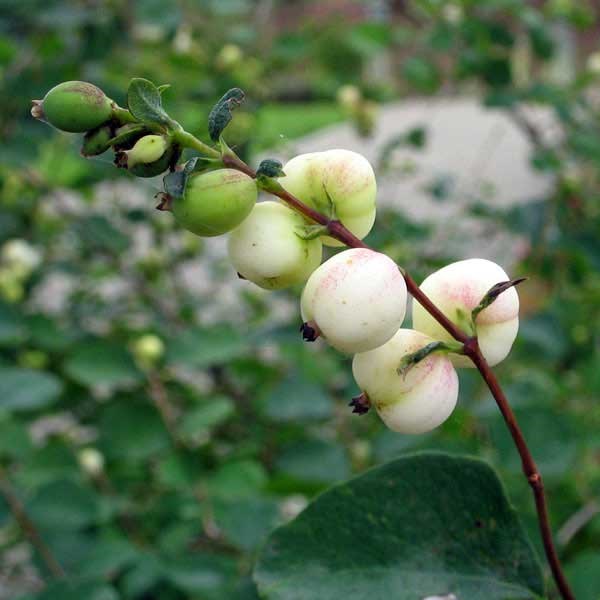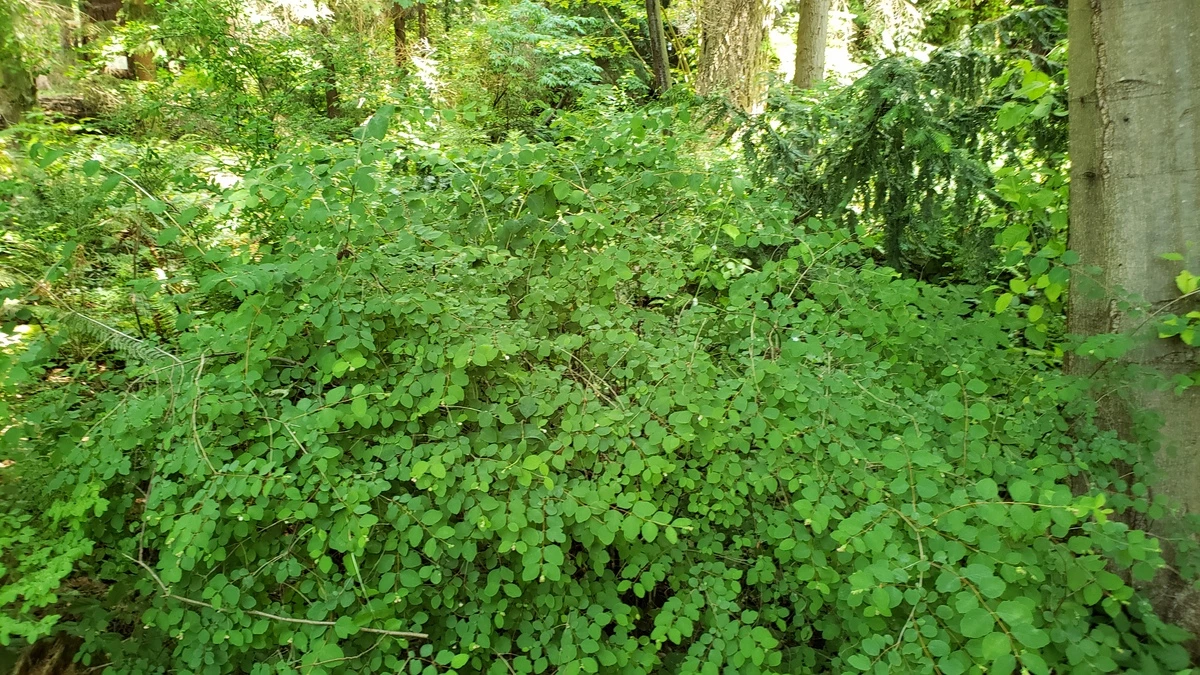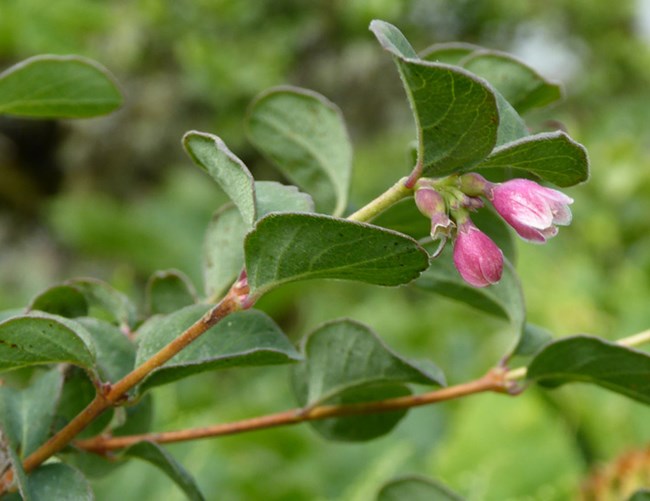Last updated: February 28, 2022
Article
Common Snowberry

Greb Rabourn, www.kingcounty.gov/gonative
General Description
Winter is the snowberry’s season. A wintry walk may reveal snowberry as a leafless shrub with waxy, snow-white berries clinging to thin wiry branches. Symphoricarpos albus or common snowberry grows in a variety of wild habitats and is an attractive shrub for home gardens.
When winter gives way to spring, tiny leaf buds unfold into simple but often irregular, oval-shaped leaves (1–3 cm long to 6 cm on new shoots). The new shoots often have larger leaves with hairy undersides and are the most irregular shaped. They can be deeply lobed. The leaf margins (edges) can be smooth, lobed, or wavy-toothed. Leaves grow opposite on multi-branched limbs. Tiny, inconspicuous pinkish flowers (4–6 mm long) hang in clusters on the ends of branches. Similar to other species in the Caprifoliaceae or honeysuckle family, snowberry flowers are distinctly bell-shaped.
In late summer and autumn, fertilized flowers develop into round green fruits, which ripen into puffy white berries (8–12 mm across). Eventually, the green leaves turn yellow and fall from the branches leaving behind the berries that persist on the shrub through winter.
The scientific name Symphori originates from the Greek word, symphorein, meaning bear together; carpos or karpos in Greek means fruit; and albus is white. Therefore, snowberry is named for its white fruit that grows or bears together in closely packed clusters.

Wendy Cutler, CC BY-SA 2.0

Margo Bors
Habitat and Distribution
Snowberry is native to the Pacific Northwest, and commonly found from low to mid elevations below 1,219 meters (4,000 ft) both east and west of the Cascades. This shrub grows in woodlands, along streambanks, and on north facing slopes – from southeast Alaska to southern California and all across the northern United States and Canadian provinces. Snowberry is naturalized in the eastern United States, which means that it is not native to that region but over time it has proved to thrive and establish populations on its own there.
Reproduction
Snowberry rarely regenerates by seed. The primary method for reproduction is through sprouting from underground stems called rhizomes. Rhizomes sprout after fire or other disturbances. In fire prone areas, plants sprouting from rhizomes are often the first plants to recolonize.
Ecology
The ability to sprout by rhizomes enables snowberry to create thickets or dense groupings that provide habitat for birds and small mammals. The flowers attract pollinators such as song birds, hummingbirds, butterflies, and bees. Songbirds and bears are known to eat the winter berries. Mice and rabbits eat the stems, while elk and deer prefer the leaves. In the Pacific Northwest, the sphinx moth (Spinx vashti) feeds on snowberry during its larval stage.
Snowberry is an important species widely used in restoration projects. Snowberry prefers well drained soils, but it can tolerate wet and dry conditions, and nutrient poor soils. Although snowberry grows best in part sun, it can also tolerate shade and full sun. Snowberry’s deep and rigorous roots make it an ideal species to plant on slopes for erosion control and along riparian zones for bank stabilization projects.
Ethnobotanical Uses
Snowberry fruits contain saponin, a naturally soapy substance with antioxidant and antimicrobial effects on the skin. Fresh berries can be crushed and rubbed on skin to cleanse and soothe; they also heal rashes and burns. Native Americans used the berries to clean their hair. Roots were soaked to make tea to treat stomach disorders, and tea made from twigs treated fevers. The spindly branches can be tied together to make brooms. The berries are not edible for humans as they are distasteful. They are considered toxic if eaten in large quantity.
Where to See
Symphoricarpos albus occurs at Crater Lake NP, Oregon Caves NMP, Redwood NSP, and Whiskeytown NRA. Other species of snowberry can be found in Lassen Volcanic NP and Lava Beds NM.
Learn More
https://plants.usda.gov/DocumentLibrary/factsheet/pdf/fs_syal.pdf

Download a pdf of this article.
Prepared by Jennifer Chenoweth
NPS Klamath Inventory & Monitoring Network
Southern Oregon University
1250 Siskiyou Blvd
Ashland, OR 97520
Featured Creature Edition: February 2022
Thumbnail image credit: Greg Rabourn, www.kingcounty.gov/gonative
